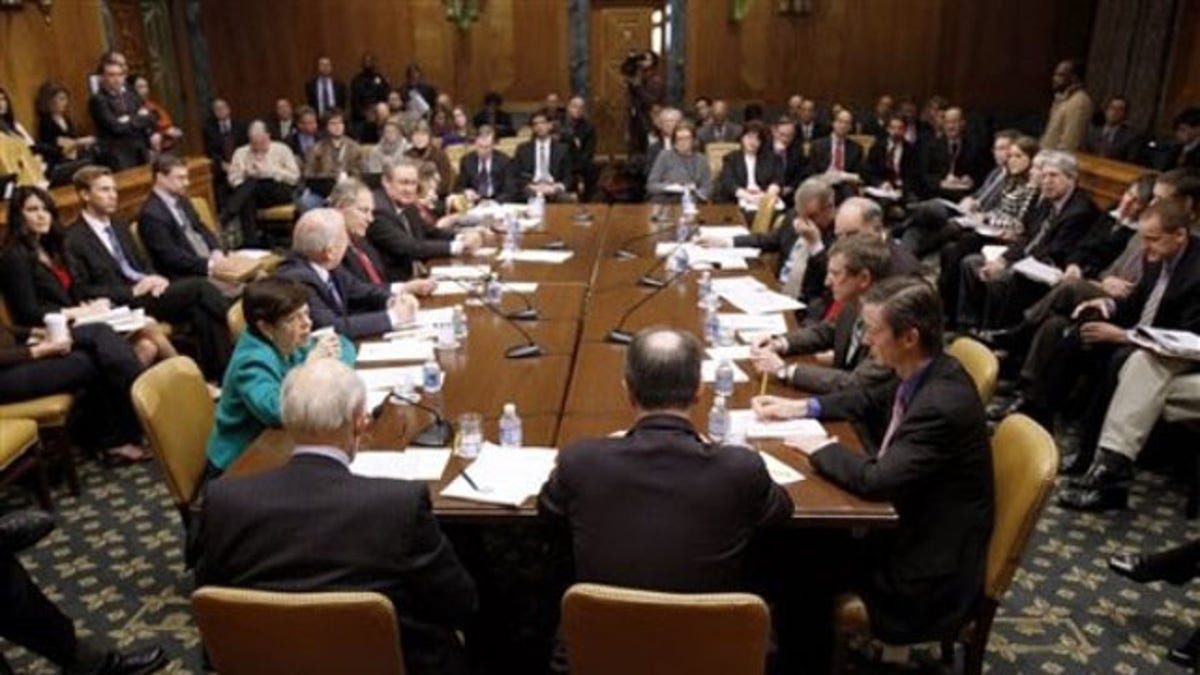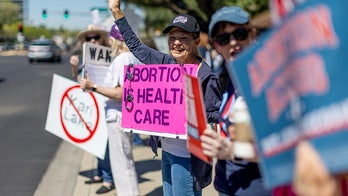
The Commission on Fiscal Responsibility and Reform meets on Capitol Hill Dec. 3, 2010. (AP)
Got a problem? Form a committee.
For decades, this has been Washington's go-to response for tackling an array of policy challenges big and small, national and local. But that response has added up.
The federal government hosts a network of 1,000 advisory panels that consisted of more than 74,000 members last year, and they are becoming increasingly expensive -- statistics kept by the federal government show the cost of running these committees has nearly doubled over the past decade.
Though the staggering number of committees has remained fairly constant during that time, the bill they rack up every year has grown rapidly, from $215 million in fiscal year 2000 to $386 million last fiscal year. The collective budget is projected to top $400 million for the 2011 budget year.
It's unclear why the price tag is rising so much at a time when inflation is not, though the bulk of the increase can be found in the cost of paying federal staff who work for these committees. That has some government watchdogs and lawmakers paying attention, and questioning whether Washington really needs tens of thousands of committee members advising the public on everything from pesticides to actuarial examinations.
"Some serve a legitimate purpose, but most of them are just bogus ways for some official to appoint who knows who," Rep. Jason Chaffetz, R-Utah, told FoxNews.com. "It's a way to punt a tough question."
Plus, he said, "It's very costly."
Chaffetz plans to introduce legislation next month aimed at requiring the executive branch to reduce the number of advisory committees. He said his "gut" instinct is to get rid of them all, but he suggested a review process might have to be implemented.
"I want to make sure we're not getting rid of a committee to oversee nuclear codes," he said.
According to government statistics, there were 74,346 committee members last year, up from about 52,000 a decade ago. Some work on these committees on a volunteer basis; for those who don't, the cost of paying them topped $47 million last year. Separate from that, the largest single cost -- at $180 million, up from $100 million a decade ago -- comes from funding the staff who do the grunt work. Another big factor is travel and related expenses, which amounted to $72 million last year.
As with most expenses outside of Medicare, Social Security and defense spending, these costs are small potatoes when compared with the federal budget shortfall now consistently north of $1 trillion.
But sometimes what they produce is difficult to gauge. A 2010 report showed just 8 percent of committee recommendations had been or will be fully implemented. About a fifth of all committees deal with reviewing grant applications; most committees, though, report "trust in government" as one of their most vital services. Only 35 committees reported tackling any kind of cost-savings for the government.
Their productivity and subject matter span the gamut. Hundreds of these committees reported meeting just a few times last year, or not meeting at all. Others reported meeting hundreds of times. Together, they produced more than 800 reports.
Some of the panels deal with very serious subject matter, like those advising the Department of Health and Human Services, where nearly half of the annual committee costs can be found. The department hears from panels on cancer, on drug abuse, on vaccines and on kidney disease, among other items.
The Department of Energy hears from two-dozen panels -- the cost of running these in 2009 was about $7 million. An Energy Department aide said the costs come from things like travel and that the department opts not to pay salaries to any committee members. The aide noted that one of the panels, the Blue Ribbon Commission on America's Nuclear Future, is expected to issue a major report this summer to the president on nuclear energy.
Other panels are more obscure, though not always as expensive to run. As of last year, the Department of Homeland Security had a Towing Safety Advisory Committee. The Federal Communications Commission had an Advisory Committee on Diversity for Communications in the Digital Age. The U.S. Commission on Civil Rights, by law, hears from an advisory committee representing each state and the District of Columbia.
The local civil rights committees have recently released reports on, among other subjects, barriers faced by immigrants in New Jersey and high-school dropout rates in Connecticut. Lenore Ostrowsky, spokeswoman for the U.S. Commission on Civil Rights, said the reports are aimed more at state and federal lawmakers, since the central commission has "zero enforcement authority" and cannot implement recommendations.
She said it's challenging for the central commission to keep finding new members for all 51 local committees, calling it a "neverending process." But even though the commission has just six regional offices, she said nobody has discussed trying to change the law to consolidate the local advisory committees.
"I think it's accepted as part of the unique functioning of this commission," she said.
The committees are not opaque. They report on their activities through the Federal Advisory Committees Database, which is open to the public by law. In their reports, the committees offer explanations justifying why they continue to exist and why the information they provide can't be obtained elsewhere. The National Cancer Advisory Board, for instance, reports that its advice on policy and research needs cannot be obtained from the National Institutes of Health.
Though the number of committees has not changed much since 10 years ago, there was a spike last year when 147 new committees were formed while just 40 were dismantled. Among them was the National Commission on Fiscal Responsibility and Reform, a closely watched panel whose president-directed task was to find ways to bring down the debt and deficit. The commission issued a comprehensive, not to mention controversial, set of recommendations last year, but it did not earn the votes to clear the commission and be voted on in Congress. In the process, the commission racked up about a half-million dollars in expenses since its inception.
David Williams, vice president of policy for watchdog Citizens Against Government Waste, said he was disturbed to learn how many committees exist simply to advise the federal government.
"It's really just a function of the federal government. They never cut back on anything. It always expands, the bureaucracy always expands. It never contracts," Williams said, urging the government to more frequently review whether each committee is necessary.
"Taxpayers should be asking themselves, what kind of bang are we getting for this?" he said.




